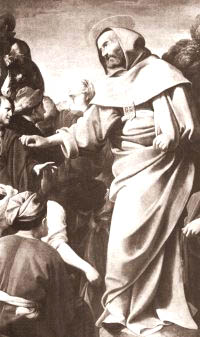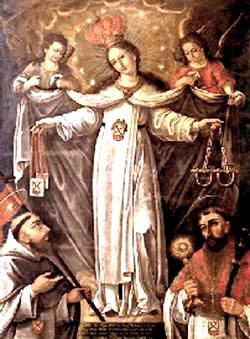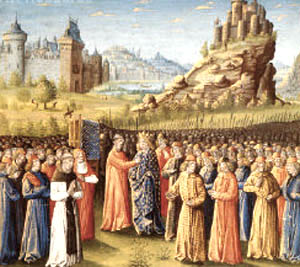 |
The Saint of the Day
St. Raymond Nonnatus, August 31
Prof. Plinio Correa de Oliveira
Biographical selection:
St. Raymond Nonnatus was born in Portella in the Diocese of Urgel, Catalonia, around the year 1203. He received the name of Raymond at his Baptism and the nickname of Nonnatus [non natus in Latin means not born] because he was not born normally, but was delivered by a caesarian operation. His father was a shepherd according to some, and a member of the noble family of Cardona, according to others.

St. Raymond Nonnatus
|
From the time he was very young, he manifested a great devotion to the Most Holy Virgin. He prayed the Rosary every day in the hermitage of St. Nicholas of Mira. Once Our Lady appeared to him and promised him her protection. Afterward he was strongly tempted to sin against chastity, but did not fall. He went to thank his Patroness and consecrated his virginity to her. Mary appeared to him again, showing her satisfaction and advising him to enter the Order of the Mercedarians, whose foundation she had inspired St. Peter Nolasco to make only shortly before, in 1218.
He was ordained a priest and dedicated himself to the redemption of captives until 1231. He liberated 140 captives in Valencia, 250 in Argel, and 28 in Tunis. It was in this last city that he had the occasion to fulfill the special fourth vow of the Mercedarians to offer themselves to remain in captivity in the place of Catholic prisoners. Since he was unable to pay the ransom demanded by the slave dealers in Tunis, Raymond offered himself to take the place of some prisoners.
The trade was made, and he began a hard captivity. To prevent him from speaking about Our Lord, for his engaging words were converting numerous Muslims, the Arabian slave masters pierced his lips with a red-hot iron and closed them with a padlock. This padlock was only opened for him to eat. After eight months of this torment, other Mercedarians arrived from Spain bringing the demanded ransom.
The last ten years of his life were spent in Rome, where he became the representative of his Order and in traveling throughout different countries to preach the Crusade. As a cardinal representative of Pope Gregory IX he was sent to meet with St. Louis of France and encourage him to go on the Crusade, which actually took place 10 years later.
St. Raymond Nonnatus died in Cardona, a Spanish village close to Barcelona, on August 31, 1240. He was only 37-years-old.
Comments of Prof. Plinio:
The life of St. Raymond Nonnatus is a life filled with extraordinary facts. Among them, let me note first the sign Our Lady gave him that led him to the Order of the Mercedarians.

Our Lady of Ransom
|
Second, you can see that the epopee of his action in the redemption of slaves reached its apex with his offer to deliver himself as a slave to ransom Catholic prisoners.
Third, consider the torment he suffered of having a padlock perforating his lips. Imagine the enormous pain and discomfort of having a padlock cutting through one’s lips even in sleep. Think how this would bother a man and disturb his nervous system! Then, each time that he had to eat, a Moor would come and open the padlock, breaking the wounds anew and causing new sufferings. Closing it would produce additional torments. Was he allowed to drink water during the day? Can you imagine the discomfort of drinking anything in this situation? He endured this life for the period of eight months.
What did he do when he was freed? Did he have a psychological breakdown? Become discouraged? Feel sorry for himself? No. He took an extraordinarily manly attitude and returned to a life of intense activity. You see how he resisted the temptations to feel sorry for himself and stop fighting for the Catholic cause. His attitude demanded a highly supernatural spirit and a strong virile personality. You see the astonishing fortitude of soul such a man had. He returned and continued an active life for another ten years or so.
He traveled throughout Europe as an ambassador of the Pope and a preacher of the Crusade. What a powerful impression the word of his sermons delivered by his wounded lips must have made on the people!

A religious entering a city to preach the Crusade
|
He was a character worthy to preach a Crusade. You understand why the Crusades were so well accepted in the Middle Ages when you know that men like St. Raymond Nonnatus preached them. Their audiences accepted the great sacrifice of going on the Crusades following the examples of the sacrifice of the Saints that preached them.
Imagine such a scene. St. Raymond Nonnatus arriving in a city; the bells ringing and the word spreading that Fr. Raymond – the one with the wounded lips – is in town to preach a Crusade on behalf of the Pope. All the nobles and people of the area gather around with their families and he begins to speak.
He speaks about the meaning of the Sepulcher of Our Lord Jesus Christ and what its profanation represents. How it is necessary to re-conquer it for the glory of God and Catholic honor. He speaks with the voice and prestige of a saint, with the supernatural power of communication that only the saints have.

The hearts of men opened to saints
like St. Raymond Nonnatus and St. Bernard (above) who preached the Crusade
|
The hearts of the knights begin to be touched, the ladies weep and give their consent for their husbands to go and fight for the Holy Land. Everyone goes to Confession and the date of the Crusade is announced. The practical preparations start. All this happens because a saint passes through that area.
This imaginary scene may help you to understand what the Middle Ages was. The influence of the saints and the good reception the people gave them is what really explains why the Middle Ages had so many wonderful things and our epoch does not. The key is the presence of the saints and the openness people had for them. How few saints there are today! Knowing this, we understand the tragedy of the contemporary situation of the Church and the world.
Let us ask St. Raymond Nonnatus to give us more saints to regenerate the Church and the world, and make the modern man recognize them and be receptive to their message.


  | | Prof. Plinio Corrêa de Oliveira | |
The Saint of the Day features highlights from the lives of saints based on comments made by the late Prof. Plinio Corrêa de Oliveira. Following the example of St. John Bosco who used to make similar talks for the boys of his College, each evening it was Prof. Plinio’s custom to make a short commentary on the lives of the next day’s saint in a meeting for youth in order to encourage them in the practice of virtue and love for the Catholic Church. TIA thought that its readers could profit from these valuable commentaries.
The texts of both the biographical data and the comments come from personal notes taken by Atila S. Guimarães from 1964 to 1995. Given the fact that the source is a personal notebook, it is possible that at times the biographic notes transcribed here will not rigorously follow the original text read by Prof. Plinio. The commentaries have also been adapted and translated for TIA’s site.
|
Saint of the Day | Home | Books | CDs | Search | Contact Us | Donate

© 2002- Tradition in Action, Inc. All Rights Reserved
|
 |

|